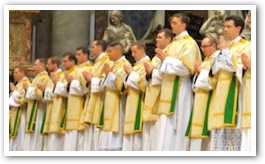The Color of Liturgical Vestments
- FR. WILLIAM SAUNDERS
Would you please explain the different colors used at Mass and the vestments? In my travels, I have even seen blue and black vestments which I have never seen before.
 |
The Church's liturgical norms do prescribe specific vestment colors for various celebrations. The purpose of utilizing different colors for vestments is twofold: first, the colors highlight the particular liturgical season and the faithful's journey through these seasons. Second, the colors punctuate the liturgical season by highlighting a particular event or particular mystery of faith. The following explanation is based on the norms of The General Instruction on the Roman Missal.
White or gold, a color symbolizing rejoicing and purity of soul, is worn during the liturgical seasons of Christmas and Easter. White vestments are also used for feasts of our Lord (except those pertaining to His passion), the Blessed Virgin Mary, the angels, and the saints who were not martyrs. White vestments are also worn on the Solemnity of St. Joseph, and the Feasts of All Saints, St. John the Baptist, St. John the Evangelist, the Chair of St. Peter, and the Conversion of St. Paul. White may also be used for Masses of Christian Burial and Masses for the Dead to signify the resurrection of our Lord, when He triumphed over sin and death, sorrow and darkness.
Red has a dual imagery: On one hand, red symbolizes the shedding of blood and is therefore used on Palm Sunday (when Christ entered Jerusalem to prepare for His death), Good Friday, any other commemoration of the Lord's passion, the votive Mass of the Precious Blood, the days marking the martyrdom of the apostles (except St. John), and the feasts of other martyrs who offered their lives for the faith.
On the other hand, red also signifies the burning fire of God's love. For this reason, red vestments are won on Pentecost when the Holy Spirit descended on the apostles and tongues of fire rested on their heads; for the celebration of the Sacrament of Confirmation; and for the votive Masses of the Holy Spirit.
Green is used during the liturgical season called Ordinary Time. This season focuses on the three-year period of our Lord's public ministry, and the Gospel passages, particularly on Sundays, recount His teachings, miracles, exorcisms, and other deeds during this time. All of these teachings and events engender great hope in the mystery of salvation. We focus on the life He shared with mankind during His time on this earth, the life we share now with Him in the community of the Church and through His sacraments, and we look forward to sharing everlasting life with Him perfectly in Heaven. Green symbolizes this hope and life, just as the hint of green on trees in early Spring arouses the hope of new life.
Violet or purple is used during Advent and Lent as a sign of penance, sacrifice and preparation. At the midpoint of both of these seasons — Gaudete Sunday (the third Sunday of Advent) and Laetare Sunday (the fourth Sunday of Lent — rose vestments are traditionally worn as a sign of joy: we rejoice at the midpoint because we are half-way through the preparation and anticipate the coming joy of Christmas or Easter. Some liturgists, particularly in the Episcopalian Church, have introduced the use of blue vestments during Advent as a way of distinguishing this season from Lent; however, no approval for blue vestments has been given for the Catholic Church. Purple vestments may also be used for Masses of Christian Burial or Masses for the Dead.
Although not seen very frequently in the United States today, black vestments may be worn for Masses of Christian Burial as a sign of death and mourning. Black may also be used on the Feast of All Souls or for any Mass of the Dead, such as on the anniversary of the death of a loved one.
In all, the colors of the vestments awaken us to the sense of sacred time. They are another visible way to make present the sacred mysteries we celebrate.
 This is Meaghen Gonzalez, Editor of CERC. I hope you appreciated this piece. We curate these articles especially for believers like you.
This is Meaghen Gonzalez, Editor of CERC. I hope you appreciated this piece. We curate these articles especially for believers like you.
Please show your appreciation by making a $3 donation. CERC is entirely reader supported.

Acknowledgement
Saunders, Rev. William. "The Color of Liturgical Vestments." Arlington Catholic Herald.
This article is reprinted with permission from Arlington Catholic Herald.
The Author

 Father William Saunders is pastor of Our Lady of Hope parish in Potomac Falls, Virginia. He is dean of the Notre Dame Graduate School of Christendom College. The above article is a "Straight Answers" column he wrote for the Arlington Catholic Herald. Father Saunders is the author of Straight Answers, a book based on 100 of his columns, and Straight Answers II.
Father William Saunders is pastor of Our Lady of Hope parish in Potomac Falls, Virginia. He is dean of the Notre Dame Graduate School of Christendom College. The above article is a "Straight Answers" column he wrote for the Arlington Catholic Herald. Father Saunders is the author of Straight Answers, a book based on 100 of his columns, and Straight Answers II.




